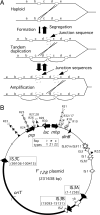Multiple pathways of selected gene amplification during adaptive mutation
- PMID: 17082307
- PMCID: PMC1633709
- DOI: 10.1073/pnas.0608309103
Multiple pathways of selected gene amplification during adaptive mutation
Abstract
In a phenomenon referred to as "adaptive mutation," a population of bacterial cells with a mutation in the lac operon (lac-) accumulates Lac+ revertants during prolonged exposure to selective growth conditions (lactose). Evidence was provided that selective conditions do not increase the mutation rate but instead favor the growth of rare cells with a duplication of the leaky lac allele. A further increase in copy number (amplification) improves growth and increases the likelihood of a sequence change by adding more mutational targets to the clone (cells and lac copies per cell). These duplications and amplifications are described here. Before selection, cells with large (134-kb) lac duplications and long junction sequences (>1 kb) were common (0.2%). The same large repeats were found after selection in cells with a low-copy-number lac amplification. Surprisingly, smaller repeats (average, 34 kb) were found in high-copy-number amplifications. The small-repeat duplications form when deletions modify a preexisting large-repeat duplication. The shorter repeat size allowed higher lac amplification and better growth on lactose. Thus, selection favors a succession of gene-amplification types that make sequence changes more probable by adding targets. These findings are relevant to genetic adaptation in any biological systems in which fitness can be increased by adding gene copies (e.g., cancer and bacterial drug resistance).
Conflict of interest statement
The authors declare no conflict of interest.
Figures





Similar articles
-
Plasmid copy number underlies adaptive mutability in bacteria.Genetics. 2014 Nov;198(3):919-33. doi: 10.1534/genetics.114.170068. Epub 2014 Aug 29. Genetics. 2014. PMID: 25173846 Free PMC article.
-
The tandem inversion duplication in Salmonella enterica: selection drives unstable precursors to final mutation types.Genetics. 2010 May;185(1):65-80. doi: 10.1534/genetics.110.114074. Epub 2010 Mar 9. Genetics. 2010. PMID: 20215473 Free PMC article.
-
The effect of genomic position on reversion of a lac frameshift mutation (lacIZ33) during non-lethal selection (adaptive mutation).Mol Microbiol. 2002 May;44(4):1017-32. doi: 10.1046/j.1365-2958.2002.02934.x. Mol Microbiol. 2002. PMID: 12010495
-
Amplification-mutagenesis--how growth under selection contributes to the origin of genetic diversity and explains the phenomenon of adaptive mutation.Res Microbiol. 2004 Jun;155(5):342-51. doi: 10.1016/j.resmic.2004.01.016. Res Microbiol. 2004. PMID: 15207866 Review.
-
Adaptive mutation and amplification in Escherichia coli: two pathways of genome adaptation under stress.Res Microbiol. 2004 Jun;155(5):352-9. doi: 10.1016/j.resmic.2004.01.020. Res Microbiol. 2004. PMID: 15207867 Review.
Cited by
-
Gross chromosomal rearrangement mediated by DNA replication in stressed cells: evidence from Escherichia coli.Ann N Y Acad Sci. 2012 Sep;1267(1):103-9. doi: 10.1111/j.1749-6632.2012.06587.x. Ann N Y Acad Sci. 2012. PMID: 22954223 Free PMC article.
-
The Origin of Mutants Under Selection: How Natural Selection Mimics Mutagenesis (Adaptive Mutation).Cold Spring Harb Perspect Biol. 2015 Jul 1;7(7):a018176. doi: 10.1101/cshperspect.a018176. Cold Spring Harb Perspect Biol. 2015. PMID: 26134316 Free PMC article. Review.
-
Expression of a cryptic secondary sigma factor gene unveils natural competence for DNA transformation in Staphylococcus aureus.PLoS Pathog. 2012;8(11):e1003003. doi: 10.1371/journal.ppat.1003003. Epub 2012 Nov 1. PLoS Pathog. 2012. PMID: 23133387 Free PMC article.
-
Biofilms 2007: broadened horizons and new emphases.J Bacteriol. 2007 Nov;189(22):7948-60. doi: 10.1128/JB.00787-07. Epub 2007 Aug 31. J Bacteriol. 2007. PMID: 17766421 Free PMC article. No abstract available.
-
Global chromosomal structural instability in a subpopulation of starving Escherichia coli cells.PLoS Genet. 2011 Aug;7(8):e1002223. doi: 10.1371/journal.pgen.1002223. Epub 2011 Aug 25. PLoS Genet. 2011. PMID: 21901104 Free PMC article.
References
Publication types
MeSH terms
Grants and funding
LinkOut - more resources
Full Text Sources

